Recently, on the advice of others on another thread, I tried to migrate a dual supply OP amp circuit to single supply version. I needed a quad OP AMP, and the logic was that since my final circuit only needed to provide 0 to about 3.5 VDC, an LM324 would do just fine. Well that was easy to try because I had some on hand, but the result wasn't so hot. It turns out that my circuit must drive the equivalent of about 10K tied to +V, as in this simplified test diagram...
The result with the LM324 was that the output under these circumstances was a dismal 650 mVDC, a very LONG way from the hoped output of near zero.
This makes sense... the LM324 uses ordinary bipolar transistors for its output stages and that's about the best you can hope for. So I poked around and found a Texas Inst. quad OP AMP, the TLC274. It uses FETs for all its internal circuitry and its data sheet actually DOES mention its output includes the negative supply rail.
Unfortunately it certainly won't go to the negative rail with any load. In the example shown the best the TLC 274 could do was about 90 mV. Granted that is hugely better than the LM324, but its still a LONG way from zero. To be practical, I'd like the output in the situation depicted in my schematic to be 20 mV or less. Had I stuck with my earlier dual supply OP amps, of course this would not be an issue. But a negative supply is not available without a charge pump oscillator or similar trick requiring more parts so I'd like to stick with a single supply OP amp if I can. I'm just at a loss as to what OP amp specification I should be looking at so I don't keep running into his same problem. TI is pretty fast at sending samples, but ask them for support on a question like this and you can expect to wait a month.
Addendum:
The answers I received here have really enlightened me, and I want to thank those of you who chimed in. I have pored over the specs of several so called "rail to rail" op amps and have requested a few samples, but what I've really learned here is that "rail to rail" is a relative term, and a single supply OP amp may not be the best choice for my situation.
It is indeed a stretch to expect even the best CMOS drive OP-AMps to have an effective resistance low enough to ensure a 20mV or less output against a 1mA pull up load, and even more a stretch to think it would be sufficiently consistent between parts. The truth is that if I want precision control down near zero, a dual supply OP-AMP is a much better choice, if only because "0" really is not "0" with a dual supply, but only a "reference point" between +/- V supplies. Such a reference point can always be adjusted or trimmed as close to zero as necessary.
So since I don't have a V- supply available in my case, I have two choices. Either find a way to alter the circuit I am driving to eliminate the 10K pull up to +10VDC, or revert to a dual supply OP-AMP. To make this work I'll need to add a second OP amp package configured as oscillator and charge pump, to develop a negative supply for the second package. I've done this before and found that just a few volts of V- supply is usually sufficient to build up a good DC amplifier with good accuracy around 0 volts, with a little attention given to the source of the virtual "0" reference.
In any case I now understand that for such a precision DC amplifier, with good drive around 0 volts, it is nearly futile to expect a rail to rail OP AMP to automatically be a good solution. Its not the conclusion I'd hoped for, but win or lose its always good when you come away more educated.

